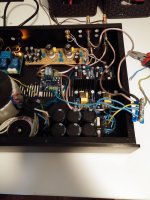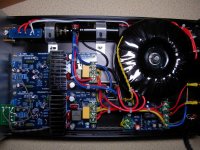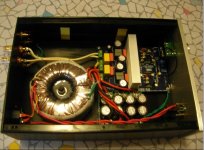Okey.. another problem has occurd. I tried for the first time to connect it to my onkyo reciver from its preouts, and i there came LOTS of noise! I have on my test bench only used it with my ipad directly connected and then its no noise. WTF????
So the problems are as follow:
- Low transformer hum when no inputs are connected, but totally silent when RCA>jack>Ipad is connected. Works great.
- When onkyo reciver is connected Lots of static and noise.
Gonna try to bypass the tube buffrer when connecting to the onkyo..
So ,
No hum problem when you got RCA's plugged in .
Whenever you use your amp listening to music , your RCA's are plugged in , so NO hum problem . My ( Very expensive ) Luxman amplifier is humming a bit when I have nothing connected on some inputs .I agree with Jlester on using GOOD QUALITY shielded cable in your amp .
I had noise problems when I first connected my UMC-1 preamp to the LJM's
I used the cheap RCA cables to connect ( The ones you find in the box when you buy a DVD player or set top box ) . After I bought some decent ones , the noise problem was gone !
Was wondering if you twisted your speaker - and PSU wires in your amp as I suggested and keep them far away from low signal wires .
Also keep your external speaker wires away as far as possible from your interconnects between your pre and main amp .
Good luck !
Cheers ,
Rens
Last edited:
Im gonna try to use som shielded cables and twist the **** out of everything in this amp, and then we will see.
I tried connecting my amp directly to my dac and when connected it was dead silent, and sounded great. But then i tried again connecting it to my onkyo and got loads of hum and nosie when connected.
And i use some insanely expensiv Van den hul MC silver it65 signal cables, but im gonna try with some Tara labs cables, might do some magic.
I tried connecting my amp directly to my dac and when connected it was dead silent, and sounded great. But then i tried again connecting it to my onkyo and got loads of hum and nosie when connected.
And i use some insanely expensiv Van den hul MC silver it65 signal cables, but im gonna try with some Tara labs cables, might do some magic.
Im gonna try to use som shielded cables and twist the **** out of everything in this amp, and then we will see.
I tried connecting my amp directly to my dac and when connected it was dead silent, and sounded great. But then i tried again connecting it to my onkyo and got loads of hum and nosie when connected.
And i use some insanely expensiv Van den hul MC silver it65 signal cables, but im gonna try with some Tara labs cables, might do some magic.
DIY is so much fun ! one day it works !
Cheers ,
Rens
hahaha Diy is funny. Its All Try and Fail.
I removed The Groudning for the Mains cabel, and poof the static that i got when it was connected to the onkyo is gone!
Can it be since the onkyo isnt mains grounded it cant use a mains grounded power amp? Ground loop?
PS:
Damn this amp sound good now after i upgraded all the capacitors on the amp boards, and got the tube buffrer! Plays SMoooth on my Sonus Faber Venere 3.0
I removed The Groudning for the Mains cabel, and poof the static that i got when it was connected to the onkyo is gone!
Can it be since the onkyo isnt mains grounded it cant use a mains grounded power amp? Ground loop?
PS:
Damn this amp sound good now after i upgraded all the capacitors on the amp boards, and got the tube buffrer! Plays SMoooth on my Sonus Faber Venere 3.0
Last edited:
Nice speakers !hahaha Diy is funny. Its All Try and Fail.
I removed The Groudning for the Mains cabel, and poof the static that i got when it was connected to the onkyo is gone!
Can it be since the onkyo isnt mains grounded it cant use a mains grounded power amp? Ground loop?
PS:
Damn this amp sound good now after i upgraded all the capacitors on the amp boards, and got the tube buffrer! Plays SMoooth on my Sonus Faber Venere 3.0
Very dangerous lifting the ground of your chassis !
Did you try isolating your star ground from the chassis as I suggested ?
If that works you could reconnect the mains ground yo the chassis and be safe again .
Cheers ,
Rens
I know its dangerous to remove the safety ground thats what i want to avoid!.
Do you mean to ground everything together but not tocuhing the chassis? Can you draw it up for me? this damn grounding is Complicated! ive read so much about grounding these last few days!
I was also thinking about making a ground loop breaker? then i also can keep my safety ground.
Yeah the speakers are nice! i have a full set of Sonus Faber speakers with the veneres 3.0 fronts and Cremona senter! I am making a full set of Holton Aussie amplifiers to drive them! This L25D amplifier i see as a challenge to see how good sound i can get out of it!
Edit:
I see that in an article about grounding that they advise to isolate the star ground from chassis and then connect it to the chassis with a CL-60 thermistor. And of have a mains safety ground right down from the IEC plug
Do you mean to ground everything together but not tocuhing the chassis? Can you draw it up for me? this damn grounding is Complicated! ive read so much about grounding these last few days!
I was also thinking about making a ground loop breaker? then i also can keep my safety ground.
Yeah the speakers are nice! i have a full set of Sonus Faber speakers with the veneres 3.0 fronts and Cremona senter! I am making a full set of Holton Aussie amplifiers to drive them! This L25D amplifier i see as a challenge to see how good sound i can get out of it!
Edit:
I see that in an article about grounding that they advise to isolate the star ground from chassis and then connect it to the chassis with a CL-60 thermistor. And of have a mains safety ground right down from the IEC plug
Last edited:
I know its dangerous to remove the safety ground thats what i want to avoid!.
Do you mean to ground everything together but not tocuhing the chassis? Can you draw it up for me? this damn grounding is Complicated! ive read so much about grounding these last few days!
I was also thinking about making a ground loop breaker? then i also can keep my safety ground.
Yeah the speakers are nice! i have a full set of Sonus Faber speakers with the veneres 3.0 fronts and Cremona senter! I am making a full set of Holton Aussie amplifiers to drive them! This L25D amplifier i see as a challenge to see how good sound i can get out of it!
Edit:
I see that in an article about grounding that they advise to isolate the star ground from chassis and then connect it to the chassis with a CL-60 thermistor. And of have a mains safety ground right down from the IEC plug
Yes , that's exactly what I mean .
I have my star grounding and PSU on a plastic cutting board with an M6 bold and some nuts and not connected to the chassis and have no hum or noise problems , but there is a lot on this forum about connecting star grounding to Mains grounding and ground loop breakers but I don't think you'll need it .
Have no time now for a drawing , have to hook my scanner up etc .just came indoors from the pool for a fresh Heineken , checked the forum and have friends over . so no DIY audio for me the next couple of hours
The Holton Amps are nice ! I heard them ,very good sound , but pretty pricy ( But that's Australia
OK Buddy ,
Have a good one !
Cheers ,
Rens
So i tried a Floating ground, where all the components where grounded together without connection to chassis or mains ground. And safety ground connected to chassis. And i got a very high hiss noise and a high pitches klicking sound. So i guess this dosent work. See picture how i floted the ground.
Im starting to belive a ground loop breaker might be my only option?

Im starting to belive a ground loop breaker might be my only option?

input caps blocking half the signal?
The input capacitor(dc blocking cap) on the L25D boards and in the IRAUDAMP7S document are polarised electrolytic caps with 22uF.
Why are polarised caps used here and not non-polarised? Is that not blocking half the signal(waveform)? I sent some dc(also reversing polarity) in there as a test(mine are taken out and replaced with wire) and the speaker cone moves in and also out.
I checked the output cap of my source DACMagic AZUR and they are non-polarised electrolytic.
Also I see lots of recommendations of swapping the L25D input caps for WIMA MKS 4. Metallized Polyester (PET) Capacitors which are non-polarised.
EDIT: sorry guys forgot to mention: mine are taken out and replaced with wire
The input capacitor(dc blocking cap) on the L25D boards and in the IRAUDAMP7S document are polarised electrolytic caps with 22uF.
Why are polarised caps used here and not non-polarised? Is that not blocking half the signal(waveform)? I sent some dc(also reversing polarity) in there as a test(mine are taken out and replaced with wire) and the speaker cone moves in and also out.
I checked the output cap of my source DACMagic AZUR and they are non-polarised electrolytic.
Also I see lots of recommendations of swapping the L25D input caps for WIMA MKS 4. Metallized Polyester (PET) Capacitors which are non-polarised.
EDIT: sorry guys forgot to mention: mine are taken out and replaced with wire
Last edited:
The input capacitor(dc blocking cap) on the L25D boards and in the IRAUDAMP7S document are polarised electrolytic caps with 22uF.
Why are polarised caps used here and not non-polarised? Is that not blocking half the signal(waveform)? I sent some dc(also reversing polarity) in there as a test(mine are taken out and replaced with wire) and the speaker cone moves in and also out.
I checked the output cap of my source DACMagic AZUR and they are non-polarised electrolytic.
Also I see lots of recommendations of swapping the L25D input caps for WIMA MKS 4. Metallized Polyester (PET) Capacitors which are non-polarised.
EDIT: sorry guys forgot to mention: mine are taken out and replaced with wire
Read this http://www.diyaudio.com/forums/parts/102867-polarized-capacitors-coupling.html
Cheers ,
Rens
The input capacitor(dc blocking cap) on the L25D boards and in the IRAUDAMP7S document are polarised electrolytic caps with 22uF.
Why are polarised caps used here and not non-polarised? Is that not blocking half the signal(waveform)? I sent some dc(also reversing polarity) in there as a test(mine are taken out and replaced with wire) and the speaker cone moves in and also out.
I checked the output cap of my source DACMagic AZUR and they are non-polarised electrolytic.
Also I see lots of recommendations of swapping the L25D input caps for WIMA MKS 4. Metallized Polyester (PET) Capacitors which are non-polarised.
EDIT: sorry guys forgot to mention: mine are taken out and replaced with wire
Electrolytic capacitors hsve been used for many years for coulping/dc blocking. There is no evidence that an electrolytic should sould sound different to a non polarised cap of the same value providing all other parameters are similar.
I suggest you email along here and ask him. He may be able to source them for you if he doesn't normally stock them. If he can I'm sure they will be at decent price too. BTW - I purchased these same amp modules from him a couple of years ago and they are the best sounding class D DIY amps I've built. Ok, so they don't compare with the class D B&O ICEPower amp modules in my Pioneer Elite HT rig!Anyone know where i can buy only the PCB to L25D without the parts??
redjr
Hope I didn't make a mistake. I ordered a couple assembled L15d-Pro boards from China. Did so before learning of the two recommended sellers & unfortunately bought from someone else. Is there anything I should check regarding the components to make sure it's up to spec of the legit boards?
I will be using a SMPS500R to power the boards rated at 45V+-. Is this sufficient or should I bump up the voltage closer to 50V?
Thanks!
Jeff
I will be using a SMPS500R to power the boards rated at 45V+-. Is this sufficient or should I bump up the voltage closer to 50V?
Thanks!
Jeff
Hi Meerp1 - I think you'll be okay. Do a good visual inspection of the boards to check for any questionable parts and solder joints. Also look to see if the little LJM bust icon is printed on the PCB. It usually is though that does not necessarily guarantee authenticity. And then of course hook em up and test away!Hope I didn't make a mistake. I ordered a couple assembled L15d-Pro boards from China. Did so before learning of the two recommended sellers & unfortunately bought from someone else. Is there anything I should check regarding the components to make sure it's up to spec of the legit boards?
I will be using a SMPS500R to power the boards rated at 45V+-. Is this sufficient or should I bump up the voltage closer to 50V?
Thanks!
Jeff
I have 6 of the L25D modules and only had 1 fail. So I can't complain too much @ $29/each. Seems like a steal to me.
I would think 45VDC+- should be sufficient - depending upon how much you like to push your speakers.
I suggest you email along here and ask him. He may be able to source them for you if he doesn't normally stock them. If he can I'm sure they will be at decent price too. BTW - I purchased these same amp modules from him a couple of years ago and they are the best sounding class D DIY amps I've built. Ok, so they don't compare with the class D B&O ICEPower amp modules in my Pioneer Elite HT rig!They still sound pretty darn good.
redjr
Thanks for the tip! He sold me 2x bare L25D pcb's for 14 USD inc shipping to norway. Good deal in my eyes
Hi Meerp1 - I think you'll be okay. Do a good visual inspection of the boards to check for any questionable parts and solder joints. Also look to see if the little LJM bust icon is printed on the PCB. It usually is though that does not necessarily guarantee authenticity. And then of course hook em up and test away!
I have 6 of the L25D modules and only had 1 fail. So I can't complain too much @ $29/each. Seems like a steal to me.
I would think 45VDC+- should be sufficient - depending upon how much you like to push your speakers.On 8 ohm loads, this amp does sound very, very good.
Thanks for the info. I'll post the outcome once I finish the amps.
Cheers,
Jeff
So i tried a Floating ground, where all the components where grounded together without connection to chassis or mains ground. And safety ground connected to chassis. And i got a very high hiss noise and a high pitches klicking sound. So i guess this dosent work. See picture how i floted the ground.
Im starting to belive a ground loop breaker might be my only option?
View attachment 395757
Stay away from the tube. Over longer distances.
Maybe you can give it a try. Only use the mono. L25D.
It can let you know the cause of the noise.
If the mono. You can think another way. For example.
Mono amplifiers. It can eliminate the power ground noise.
So i tried a Floating ground, where all the components where grounded together without connection to chassis or mains ground. And safety ground connected to chassis. And i got a very high hiss noise and a high pitches klicking sound. So i guess this dosent work. See picture how i floted the ground.
Im starting to belive a ground loop breaker might be my only option?
View attachment 395757
Stay away from the tube. Over longer distances.
Maybe you can give it a try. Only use the mono. L25D.
It can let you know the cause of the noise.
If the mono. You can think another way. For example.
Mono amplifiers. It can eliminate the power ground noise.
In addition. As far as possible can keep the same with myself or others making machine.
It can reduce a lot of trouble.
I often put the ears on the sound box
Attachments
Last edited:
- Home
- Amplifiers
- Class D
- My design L20D IRS2092+IRFI4020H 200W8R

